
Carbon Capture, Utilization, and Storage Market
Carbon Capture, Utilization, and Storage Market by Service (Capture, Utilization, Storage, Transportation), Technology (Chemical Looping, Solvents & Sorbents, Membranes), End-use Industry (Oil & Gas, Power Generation, Chemical & Petrochemical, Cement, Iron & Steel), and Region - Global Forecast to 2030




OVERVIEW
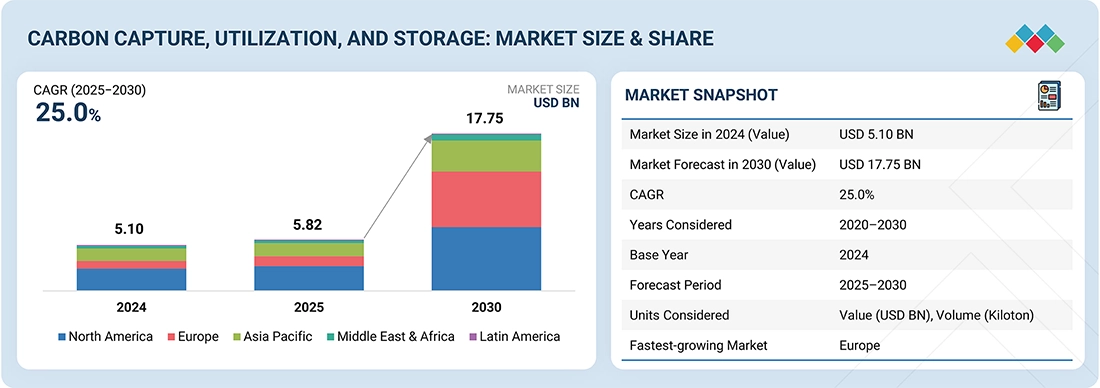
Source: Secondary Research, Interviews with Experts, MarketsandMarkets Analysis
The carbon capture, utilization, and storage market is projected to reach USD 17.75 billion by 2030 from USD 5.82 billion in 2025, at a CAGR of 25.0% from 2025 to 2030. The growth of the carbon capture, utilization, and storage market is driven by the rising emphasis on achieving zero-carbon targets and growing policy support from governments to reduce carbon emissions.
KEY TAKEAWAYS
-
BY SERVICEThe carbon capture, utilization, and storage market comprises carbon capture, storage, transportation, and utilization. Carbon capture is a key climate technology that prevents CO2 from entering the atmosphere by capturing emissions from power plants and industrial facilities. It enables hard-to-abate sectors like cement, steel, and petrochemicals to reduce their carbon footprint while supporting global net-zero targets.
-
BY TECHNOLOGYKey technologies include chemical looping, solvent & sorbents, membranes, and other technologies. Various CCUS technologies provide distinct advantages; for example, chemical looping enhances efficiency while reducing oxygen costs.
-
BY END-USE INDUSTRYThe end-use industries include oil & gas, power generation, chemicals and petrochemicals, cement, iron & steel, and other end-use industries. These industries play a crucial role in the growth of the carbon capture, utilization, and storage market, as they are the primary sources of CO2 emissions. By integrating capture, storage, and utilization solutions, these sectors are driving the large-scale adoption of CCUS as a practical approach to decarbonization.
-
BY REGIONThe carbon capture, utilization, and storage market covers Europe, North America, the Asia Pacific, South America, the Middle East, and Africa. North America is the largest market for carbon capture, utilization, and storage. It is home to several prominent oil & gas companies and is witnessing new CCUS projects with government support.
-
COMPETITIVE LANDSCAPEThe major market players have adopted both organic and inorganic strategies, including partnerships and investments. For instance, Fluor Corporation (US), Equinor ASA (Norway), and Shell plc (UK) have entered into a number of agreements and partnerships to cater to the growing demand for carbon capture, utilization, and storage across various industries.
Tightening emissions targets, rising carbon prices, and expanding financial support fuel the CCUS market, and the growing tally of new project announcements reported by the International Energy Agency (IEA) reinforces that momentum. Policymakers worldwide are establishing clear rules and incentives, tax credits, grants, and favorable loans that reduce risk and attract investment. At the same time, tougher carbon pricing makes capture technology more cost-effective than buying pollution permits. Engineering advances have driven down energy requirements and equipment costs, opening the door for projects in power plants, cement works, steel mills, and chemical factories.
TRENDS & DISRUPTIONS IMPACTING CUSTOMERS' CUSTOMERS
The impact on consumers' businesses arises from customer trends and disruptions. Hotbets are the clients of service providers in carbon capture, utilization, and storage, while target end-use industries are clients of CCUS manufacturers. Changes in trends or disruptions will affect the revenues of end users. This revenue impact on end users will, in turn, influence the revenues of hotbets, which will further affect the revenues of CCUS manufacturers.
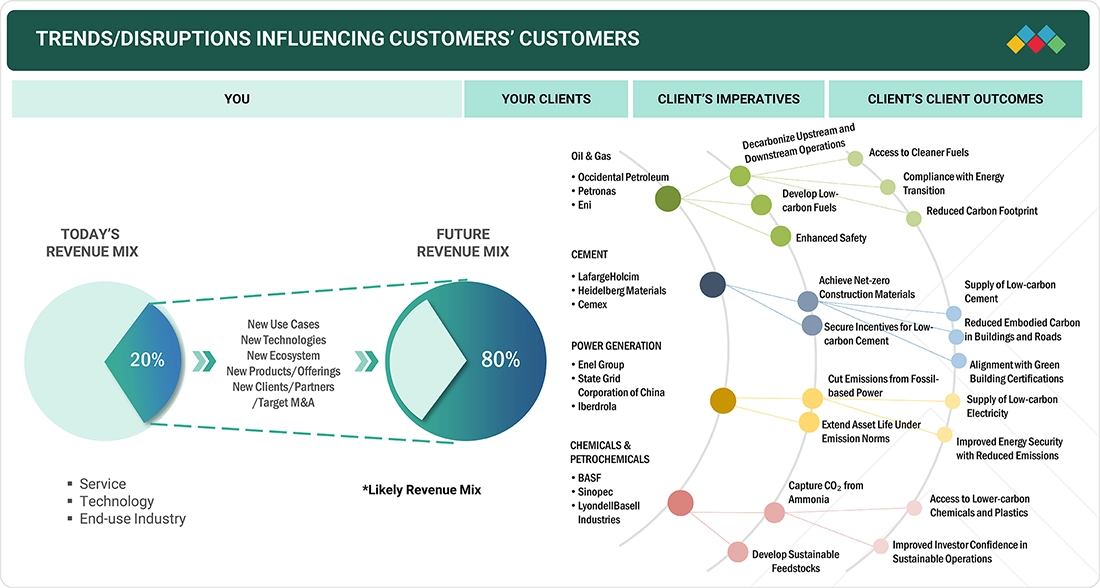
Source: Secondary Research, Interviews with Experts, MarketsandMarkets Analysis
MARKET DYNAMICS
Level
-
Growing announcements of CCUS facilities

-
Increasing demand for CO2 in EOR techniques
Level
-
High cost of carbon capture and sequestration
-
Safety concerns at storage sites
Level
-
Continuous investments to develop innovative capturing technology enable economic operations
-
Announcement of large-capacity hydrogen projects
Level
-
High initial investments
-
Transparency & Credibility risk: measurement errors, greenwashing and lobbying
Source: Secondary Research, Interviews with Experts, MarketsandMarkets Analysis
Driver: Growing announcements of CCUS facilities
As a greater number of new CCUS facilities begin operations each year, confidence in the technology continues to grow, leading to an increasing number of projects. The current pipeline features hundreds of capture sites, which range from natural gas processing plants and cement facilities to hydrogen hubs and direct air capture units. This expansion is pushing operational capacity to exceed 50 million tons (55.11 million tons) of CO2 annually, with ambitions to surpass 400 million tons (440.9 million tons) by 2030. Simultaneously, planned storage installations offer approximately 670 million tons (738.5 million tons) of underground capacity, reflecting a 10% increase compared to last year.
Restraint: High cost of carbon capture and sequestration
The high cost of carbon capture and sequestration remains one of the major barriers to market growth. This is particularly significant in developing countries and low-margin industries, as it directly impacts the economic feasibility of projects. Capturing CO2 requires advanced equipment, specialized materials, and a substantial energy input, all of which contribute to increased operational costs. The cost of capture can vary widely, typically ranging from tens to over a hundred dollars per ton, depending on the technology used and the concentration of CO2 in the emission stream. Sequestration adds further expenses due to the need for compressing CO2, transporting it through pipelines, and ensuring its secure long-term storage underground. This process also involves extensive site characterization, ongoing monitoring, and adherence to regulatory requirements. For many companies, especially those in hard-to-abate industries, the total costs often surpass short-term economic returns unless they are offset by significant government incentives, carbon pricing, or financial benefits from CO2 utilization..
Opportunity: Announcement of large-capacity hydrogen projects
The recent wave of large-scale hydrogen projects presents a significant opportunity for the CCUS industry because blue hydrogen production inherently generates high-purity CO2 streams that are far easier and cheaper to capture than dilute emissions from conventional power plants or industrial processes. As project developers finalize final investment decisions on multi-billion-dollar hydrogen facilities in North America, Europe, and Asia, they commit not only to separating hydrogen from natural gas but also to installing associated capture units capable of handling hundreds of thousands to millions of tons of CO2 per year. These projects establish key customers for transport infrastructure, including pipelines, shipping terminals, loading hubs, and dedicated storage sites like depleted reservoirs or saline aquifers.
Challenge: High initial investments
Financing a full-scale CCUS project means allocating hundreds of millions of dollars before a single ton of carbon is captured, creating a formidable barrier for developers. Every stage demands specialized work: outfitting plant exhaust with capture modules, laying pipelines for CO2 transport, building compressor stations, and preparing underground reservoirs with drilling and monitoring equipment. Site characterization alone can cost tens of millions, and unforeseen geological challenges often surface only after wells are drilled. These upfront expenditures occur long before revenue from carbon credits, enhanced oil recovery, or industrial CO2 sales begins to flow.
carbon capture utilization storage market: COMMERCIAL USE CASES ACROSS INDUSTRIES
| COMPANY | USE CASE DESCRIPTION | BENEFITS |
|---|---|---|
 |
Captures ~1.0?MtCO2/year from hydrogen production at the Scotford bitumen upgrader (oil sands heavy-oil refinery) in Alberta | Reduces the upgrader's CO2 emissions by approximately 35% |
 |
Captures ~125,000?tCO2/year from blast-furnace off-gases (and biomass) at the Ghent steel plant | Produces low-carbon ethanol, branded as Carbalyst, for fuels and chemicals, converting emissions into a sellable product |
 |
A first-of-its-kind cement CCS retrofit at Norcem’s Brevik plant captures about 400,000?tCO2/year (~50% of the plant’s emissions) from clinker production | Cuts approximately 50% of the plant’s CO2 emissions and allows for the sale of "evoZero" carbon-neutral cement |
Logos and trademarks shown above are the property of their respective owners. Their use here is for informational and illustrative purposes only.
MARKET ECOSYSTEM
The carbon capture, utilization, and storage market ecosystem consists of carbon emission sources (e.g., British Petroleum and Saudi Arabian Oil Company), carbon capture service providers (e.g., Fluor Corporation, ExxonMobil, and Equinor ASA), carbon storage & transportation service providers (e.g., CarbiCrete, Wolf Midstream, and Green Minerals), and end users (e.g., ONGC, Chevron Corporation, and JSW Group). Collaboration across the value chain is key to innovation and market growth.
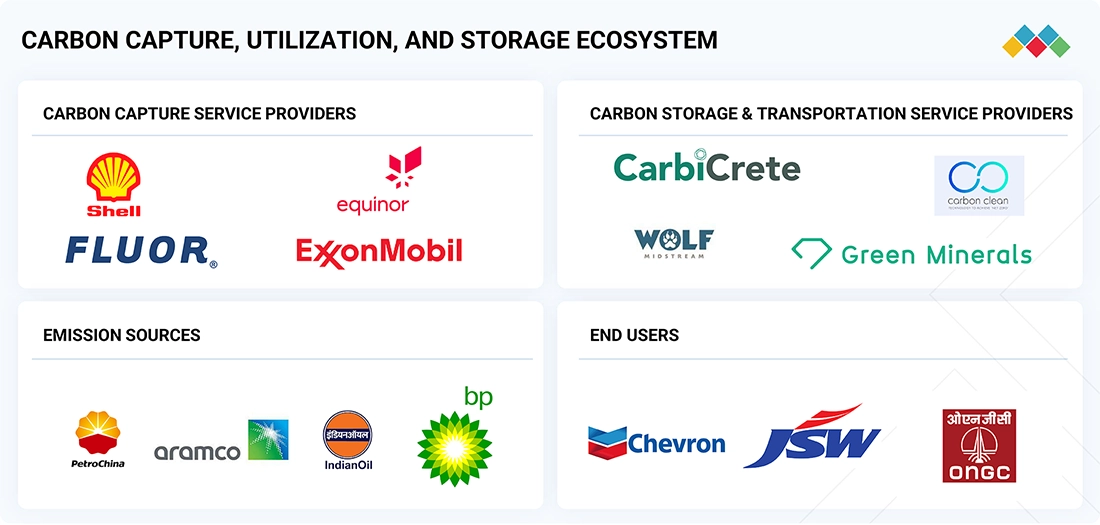
Logos and trademarks shown above are the property of their respective owners. Their use here is for informational and illustrative purposes only.
MARKET SEGMENTS
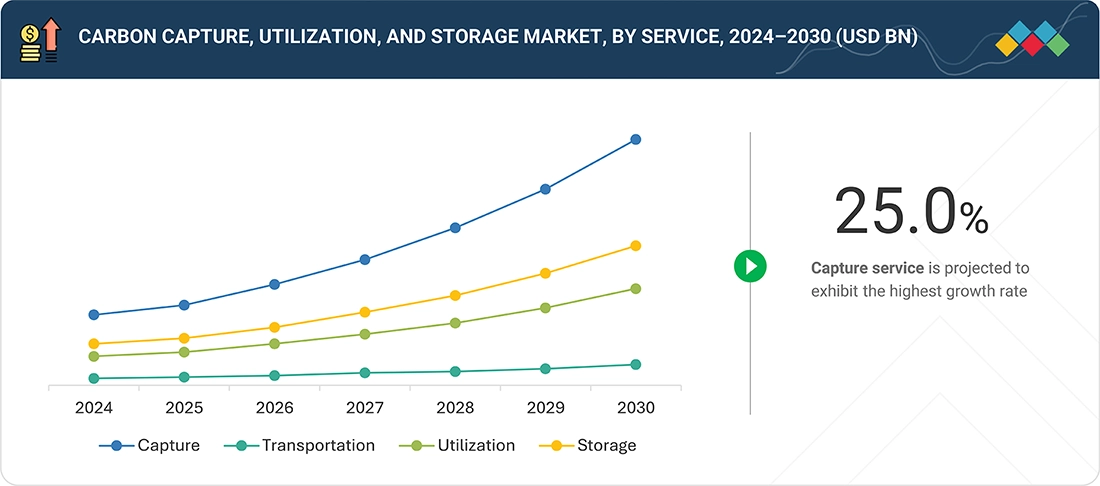
Source: Secondary Research, Interviews with Experts, MarketsandMarkets Analysis
Carbon Capture, Storage, and Utilization Market, by Service
The carbon capture segment is expected to lead the CCUS market in the forecasted period because it tackles the first and most critical step in reducing industrial and energy-related CO2 emissions, removing them directly at the source. Power stations, refineries, steel plants, cement kilns, and chemical facilities produce concentrated exhaust streams, making capture technically feasible at a large scale. These operations account for a major share of global emissions, so installing capture systems here can deliver immediate and significant reductions.
Carbon Capture, Storage, and Utilization Market, by Technology
Chemical looping is expected to be the fastest-growing technology in the forecasted period, which has improved energy efficiency and low operation cost in comparison to conventional capture processes. This technology utilizes metal oxides to shuttle oxygen for fuel combustion and thus inherently separates CO2 without using solvent regeneration, which is very expensive. This is the reason why the technologies maintain a lower energy penalty, allow the integration of various fuels (such as coal, natural gas, and biomass), and are even enticing in cases where they can co-produce some of the valuable outputs like hydrogen for both power and industrial applications.
Carbon Capture, Storage, and Utilization Market, by End-use Industry
The oil and gas sector is expected to remain the leading end-use industry in the carbon capture, utilization, and storage market until 2030. This is due to its significant contribution to concentrated CO2 emissions globally, as well as its extensive experience in subsurface reservoir management. Most CCUS installations are located near depleted oil and gas wells or large deep salt formations, making long-term storage both feasible and economically advantageous. Additionally, CO2 can be used in enhanced oil recovery within this sector, creating extra revenue opportunities and reducing capture costs.
REGION
Europe to be fastest-growing region in global carbon capture, utilization, and storage market during forecast period
Europe is anticipated to record the highest CAGR within the CCUS market in the forecasted period by virtue of its aggressive climate policies, such as the EU Green Deal and legally binding 2050 net-zero targets, which are urging massive deployment of carbon capture initiatives in the power, cement, steel, and chemical sectors. The area is favored by robust state support, carbon pricing in the EU Emissions Trading System, and cooperative cross-border projects such as the Northern Lights and Porthos ventures that combine capture, transport, and storage facilities. Europe’s established industrial base, supportive regulatory landscape, and low-carbon innovation focus provide a fertile breeding ground for explosive CCUS expansion.
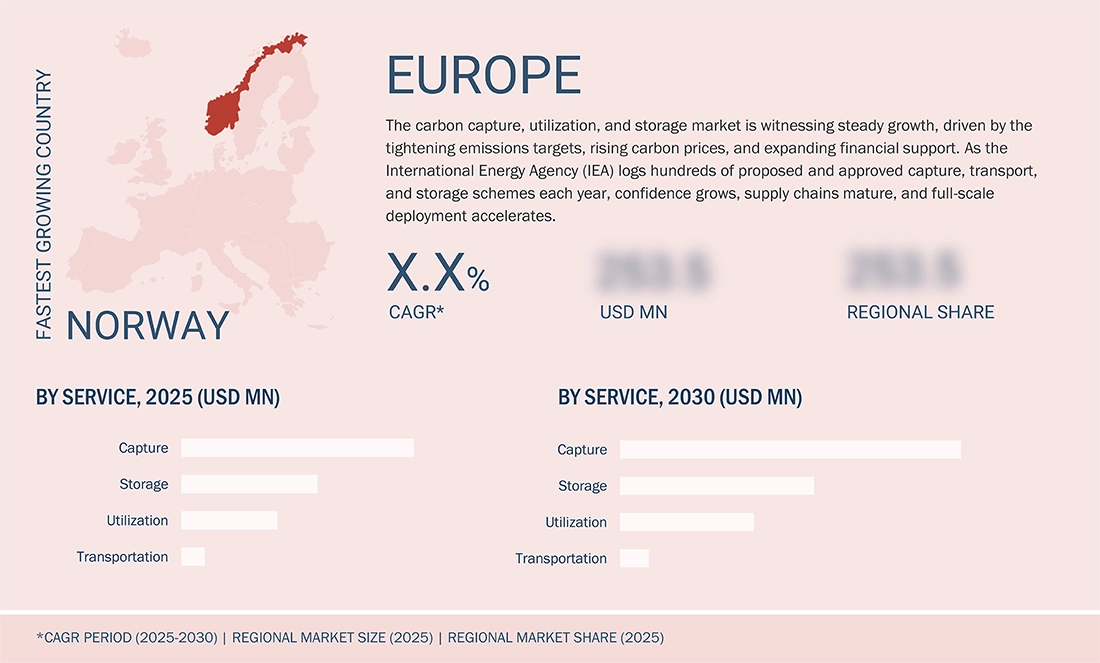
carbon capture utilization storage market: COMPANY EVALUATION MATRIX
Equinor ASA (Star) is the market leader in the carbon capture, utilization, and storage market, with the largest market share due to its pioneering Sleipner project and the Northern Lights joint venture, which together offer decades of offshore storage experience and a rapidly expanding commercial service. Linde plc (Emerging Leader) is gaining visibility due to its presence in industrial gas processing and proven CO2 capture, purification, and liquefaction technologies. Additionally, it has a number of CCUS projects lined up and has a partnership with various end-use players across different industries. While Equinor ASA dominates through scale and a diversified portfolio, Linde plc shows significant potential to move toward the leaders’ quadrant as demand for high-strength alloys continues to rise.
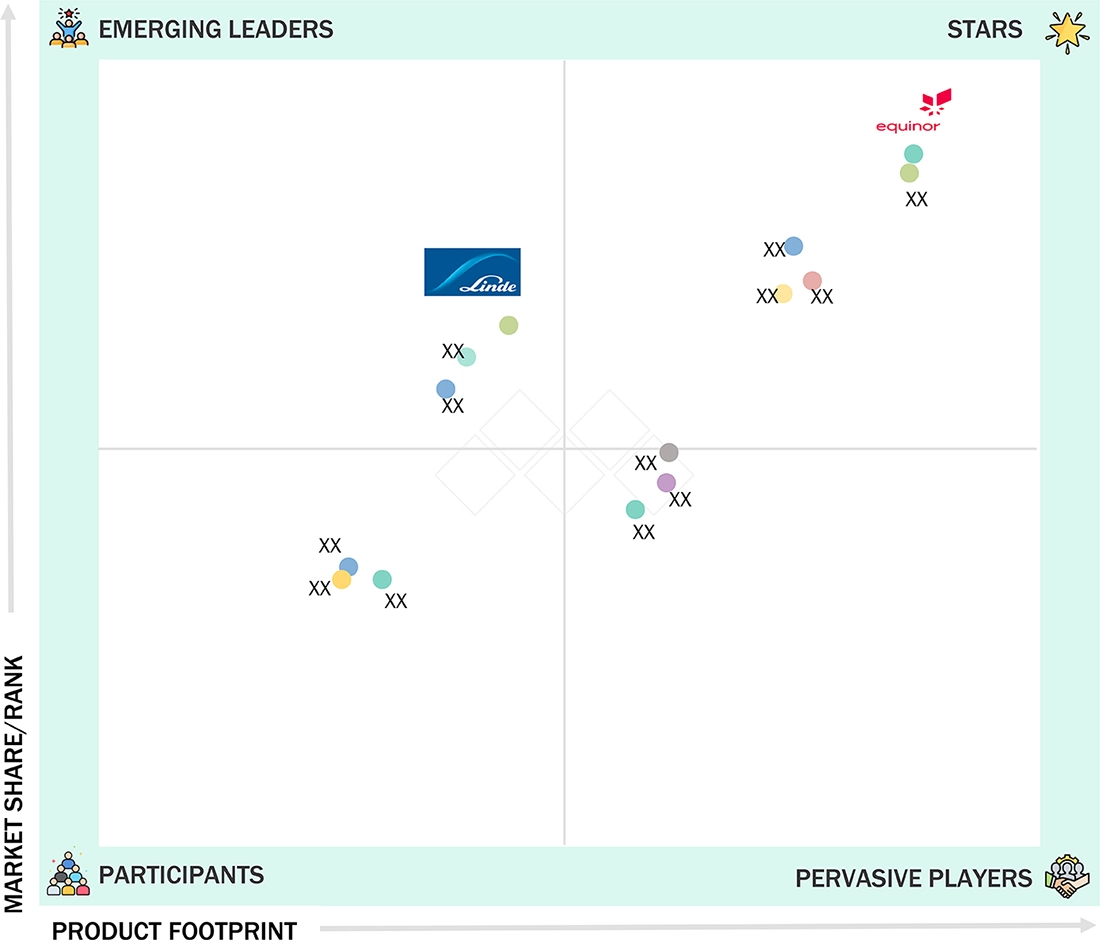
Source: Secondary Research, Interviews with Experts, MarketsandMarkets Analysis
KEY MARKET PLAYERS
- Fluor Corporation (US)
- Equinor ASA (Norway)
- TotalEnergies SE (France)
- Shell plc (UK)
- Exxon Mobil Corporation (US)
- Linde plc (UK)
- Mitsubishi Heavy Industries, Ltd. (Japan)
- JGC Holdings Corporation (Japan)
- Schlumberger Limited (US)
- Aker Solutions (Norway)
- Honeywell International (US)
- Hitachi Ltd (Japan)
- Siemens AG (Germany)
- GE Vernova (US)
- Halliburton (US)
MARKET SCOPE
| REPORT METRIC | DETAILS |
|---|---|
| Market Size in 2024 (Value) | USD 5.10 Billion |
| Market Forecast in 2030 (Value) | USD 17.75 Billion |
| Growth Rate | CAGR of 25.0% from 2025-2030 |
| Years Considered | 2020–2030 |
| Base Year | 2024 |
| Forecast Period | 2025–2030 |
| Units Considered | Value (USD Billion), Volume (Kiloton) |
| Report Coverage | Revenue forecast, company ranking, competitive landscape, growth factors, and trends |
| Segments Covered | • By Service: Capture, Storage, Utilization, and Transportation • By Technology: Chemical Looping, Solvents & Sorbents, Membranes, and Other Technologies • By End-use Industry: Oil & Gas, Power Generation, Chemical & Petrochemical, Cement, Iron & Steel, and Other End-use Industries |
| Regions Covered | Europe, North America, Asia Pacific, the Middle East & Africa, and Latin America |
WHAT IS IN IT FOR YOU: carbon capture utilization storage market REPORT CONTENT GUIDE
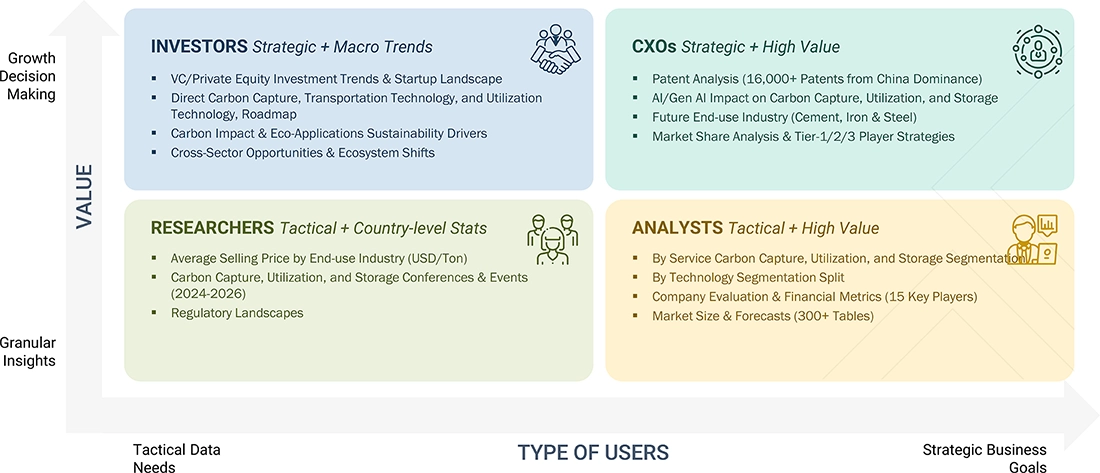
DELIVERED CUSTOMIZATIONS
We have successfully delivered the following deep-dive customizations:
| CLIENT REQUEST | CUSTOMIZATION DELIVERED | VALUE ADDS |
|---|---|---|
| Leading Carbon Capture Service Provider |
|
|
| Technology Provider |
|
|
| End User |
|
|
| Policymakers & Regulators |
|
|
RECENT DEVELOPMENTS
- April 2025 : Calpine and Exxon Mobil signed a CO2 transportation and storage agreement, under which Exxon Mobil will store up to 2 million tons (2.2 million tons) per year from Calpine’s Baytown Energy Center. The project will support the production of ~500 MW of low-carbon electricity, enough to power over 500,000 homes, while boosting US energy security and industrial competitiveness.
- April 2025 : Shell, along with partners Equinor and TotalEnergies, announced a USD 714 million investment to expand the Northern Lights CCS project, increasing its CO2 storage capacity from 1.5 to 5 million tons (1.65 to 5.5 million tons) per year. Enabled by a long-term agreement with Stockholm Exergi and supported by EU and Norwegian funding, the project marks a significant step in Europe’s decarbonization efforts, offering cross-border CO2 transport and secure offshore storage beneath the North Sea.
- April 2025 : Shell has taken Final Investment Decision (FID) on two major carbon capture and storage (CCS) developments in Canada: the Polaris CCS project at its Scotford Energy and Chemicals Park, designed to capture 650,000 tons (716,502.35 tons) of CO2 annually, and the Atlas Carbon Storage Hub, developed in partnership with ATCO EnPower, which will provide permanent underground storage for the captured CO2. These projects mark a significant expansion of Shell’s CCS portfolio.
Table of Contents

Methodology
The study involves two major activities in estimating the current market size for the carbon capture, utilization, and storage (CCUS) market. Exhaustive secondary research was done to collect information on the market, peer market, and parent market. The next step was to validate these findings, assumptions, and sizing with industry experts across the value chain through primary research. Both top-down and bottom-up approaches were employed to estimate the complete market size. After that, data triangulation was used to estimate the market size of segments and subsegments.
Secondary Research
Secondary sources referred to for this research study include financial statements of companies offering CCUS and information from various trade, business, and professional associations. Secondary research has been used to obtain critical information about the industry’s value chain, the total pool of key players, market classification, and segmentation according to industry trends, to the bottom-most level, and regional markets. The secondary data was collected and analyzed to arrive at the overall size of the CCUS market, which was validated by primary respondents.
Primary Research
Extensive primary research was conducted after obtaining information regarding the CCUS market scenario through secondary research. Several primary interviews were conducted with market experts from both the demand and supply sides across major countries of North America, Europe, Asia Pacific, the Middle East & Africa, and Latin America. Primary data was collected through questionnaires, emails, and telephonic interviews. The primary sources from the supply side included various industry experts, such as chief experience officers (CXOs), vice presidents (VPs), business development/marketing directors, product development/innovation teams, related key executives from the CCUS industry, system integrators, component providers, distributors, and key opinion leaders. Primary interviews were conducted to gather insights such as market statistics, data on revenue collected from the products and services, market breakdowns, market size estimations, market forecasting, and data triangulation. Primary research also helped understand the various trends related to fiber type, resin type, diameter, surface treatment, tensile strength, application, and region. Stakeholders from the demand side, including CIOs, CTOs, CSOs, and installation teams of customers/end users for CCUS services, were interviewed to understand the buyer’s perspective on the suppliers, products, component providers, and their current usage of CCUS and future outlook of their business, which will affect the overall market.
Breakup of Primary Research
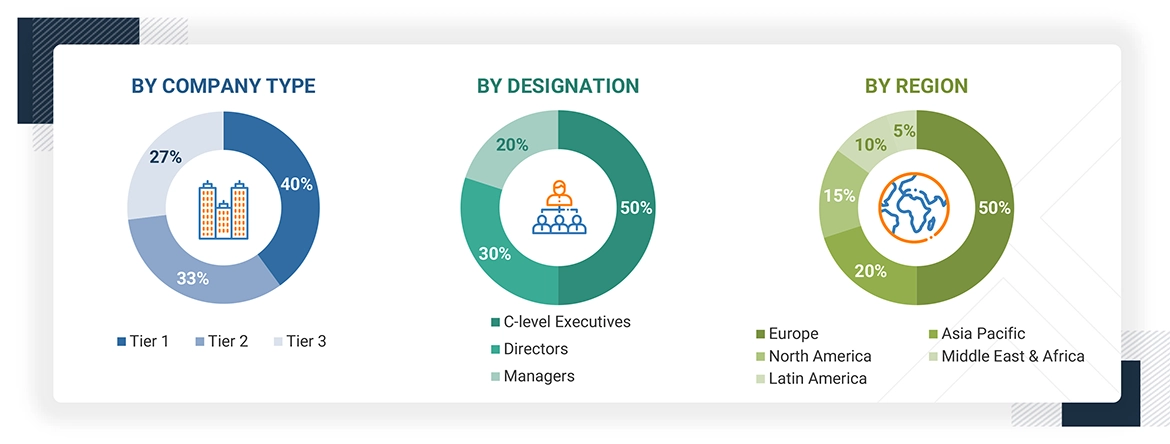
To know about the assumptions considered for the study, download the pdf brochure
Market Size Estimation
The research methodology used to estimate the size of the CCUS market includes the following details. The market size was determined from the demand side. The market was upsized based on the demand for CCUS in different applications at the regional level. Such procurements provide information on the demand aspects of the CCUS industry for each application. For each application, all possible segments of the CCUS market were integrated and mapped.
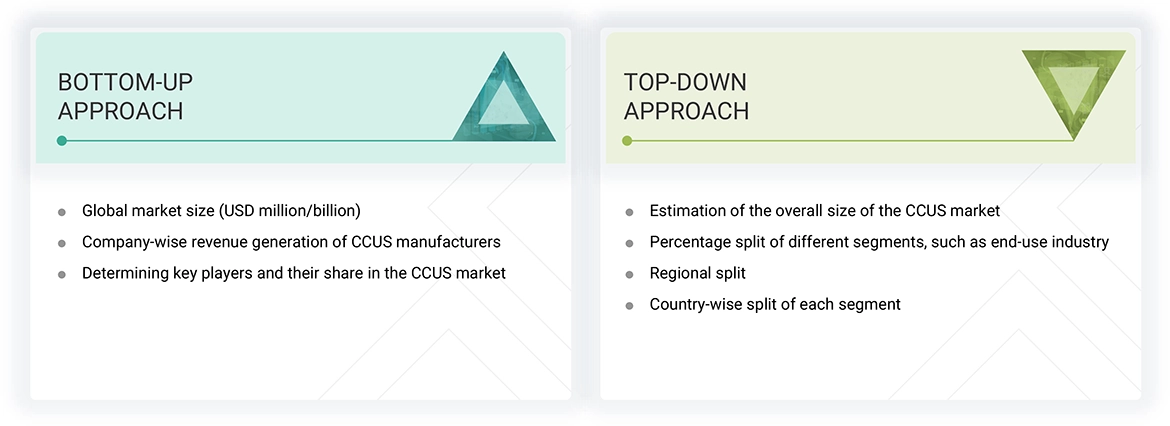
Data Triangulation
After arriving at the overall size from the market size estimation process explained above, the total market was split into several segments and subsegments. The data triangulation and market breakdown procedures explained below were implemented, wherever applicable, to complete the overall market engineering process and arrive at the exact statistics for various market segments and subsegments. The data was triangulated by studying various factors and trends from the demand and supply sides. Along with this, the market size was validated using both the top-down and bottom-up approaches.
Market Definition
CCUS involves the capture of CO2, generally from large point sources like power generation or industrial facilities that use either fossil fuels or biomass as fuel. If not used on-site, the captured CO2 is compressed and transported by pipeline, ship, rail, or truck to be used in various applications or injected into deep geological formations such as depleted oil and gas reservoirs or saline aquifers.
Stakeholders
- CCUS service providers
- Universities, governments, and research organizations
- Associations and industrial bodies
- R&D institutes
- Environmental support agencies
- Investment banks and private equity firms
- Research and consulting firms
Report Objectives
- To define, describe, and forecast the CCUS market size in terms of volume and value
- To provide detailed information regarding the key factors, such as drivers, restraints, opportunities, and challenges influencing market growth
- To analyze and project the global CCUS market by service, technology, End-use industry, and region
- To forecast the market size concerning five main regions (along with country-level data), namely, North America, Europe, Asia Pacific, the Middle East & Africa, and South America, and analyze the significant region-specific trends
- To strategically analyze micromarkets with respect to individual growth trends, prospects, and contributions of the submarkets to the overall market
- To analyze the market opportunities and the competitive landscape for stakeholders and market leaders
- To assess recent market developments and competitive strategies, such as agreements, contracts, acquisitions, and product developments/product launches, to draw the competitive landscape
- To strategically profile the key market players and comprehensively analyze their core competencies
Key Questions Addressed by the Report
Who are the major companies in the CCUS market? What key strategies have market players adopted to strengthen their market presence?
Key players include Fluor Corporation (US), Exxon Mobil Corporation (US), Linde plc (UK), Shell Plc. (UK), Mitsubishi Heavy Industries, Ltd. (Japan), JGC Holdings Corporation (Japan), Schlumberger Limited (US), Aker Solutions (Norway), Honeywell International (US), Equinor ASA (Norway), TotalEnergies SE (France), Hitachi Ltd (Japan), Siemens AG (Germany), GE Vernova (US), and Halliburton (US). Their key strategies include technology advancements, acquisitions, and expansions.
What are the drivers and opportunities for the CCUS market?
Increasing R&D activities and growing investments in the CCUS industry are key drivers fueling market growth.
Which region is projected to account for the largest market share?
North America is projected to be the largest market for CCUS due to the presence of major CCUS projects.
What is the projected growth rate of the CCUS market over the next five years?
The CCUS market is projected to grow at a CAGR of 25.0% during the forecast period, in terms of value.
How is the CCUS market aligned for future growth?
The CCUS market is rapidly expanding, driven by increasing demand in the oil & gas sector and growing government initiatives aimed at reducing carbon emissions.
Need a Tailored Report?
Customize this report to your needs
Get 10% FREE Customization
Customize This ReportPersonalize This Research
- Triangulate with your Own Data
- Get Data as per your Format and Definition
- Gain a Deeper Dive on a Specific Application, Geography, Customer or Competitor
- Any level of Personalization
Let Us Help You
- What are the Known and Unknown Adjacencies Impacting the Carbon Capture, Utilization, and Storage Market
- What will your New Revenue Sources be?
- Who will be your Top Customer; what will make them switch?
- Defend your Market Share or Win Competitors
- Get a Scorecard for Target Partners
Custom Market Research Services
We Will Customise The Research For You, In Case The Report Listed Above Does Not Meet With Your Requirements
Get 10% Free Customisation












Growth opportunities and latent adjacency in Carbon Capture, Utilization, and Storage Market